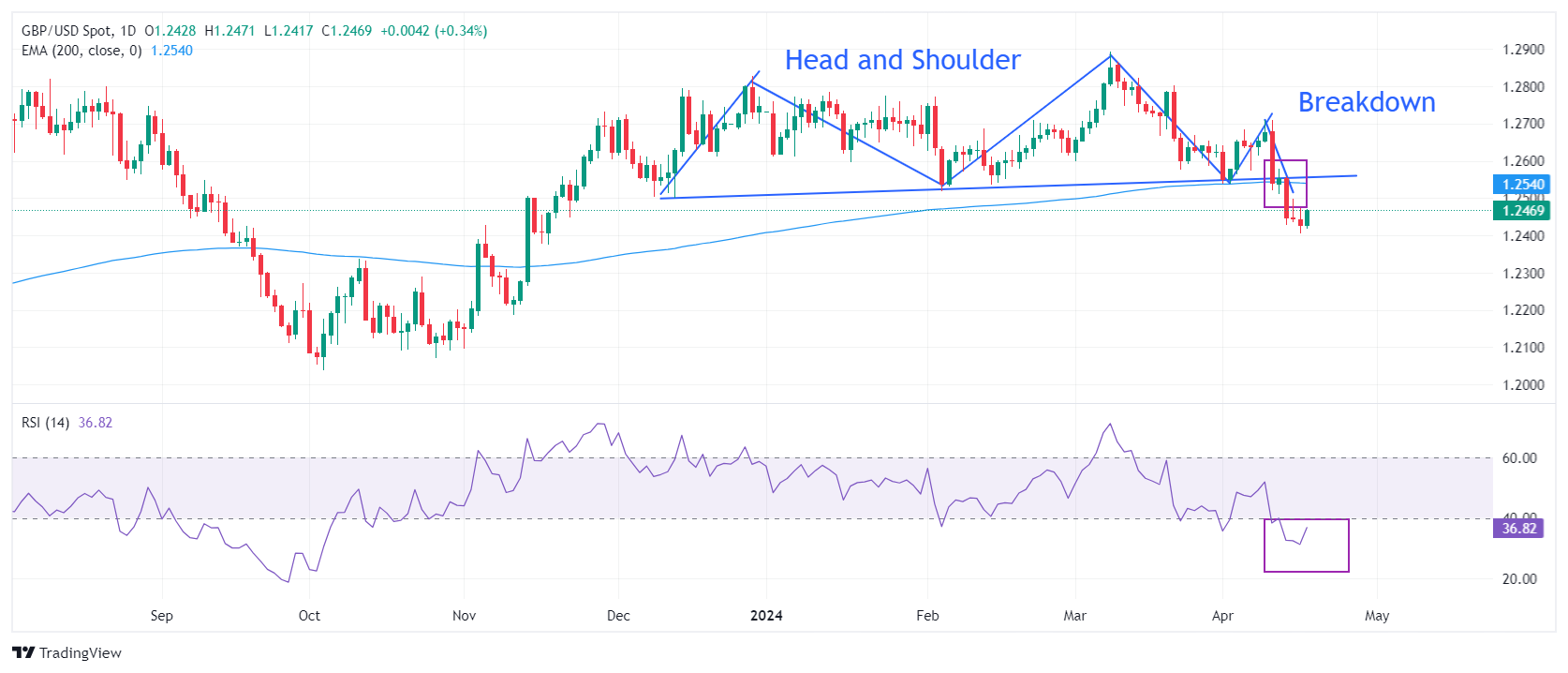Pound Sterling rises on slower than expected decline in UK inflation
- The Pound Sterling recovers above 1.2400 against the US Dollar as UK inflation rose higher than expected in March.
- UK’s annual headline and core CPI rose by 3.2% and 4.2% in March, respectively.
- Fed Powell’s hawkish guidance on interest rates has strengthened the US Dollar’s appeal.
The Pound Sterling (GBP) rebounds strongly in Wednesday’s early New York session as the United Kingdom Office for National Statistics (ONS) reported that the Consumer Price Index (CPI) for March grew more than what economists had expected. Despite beating estimates, inflation has softened from February, suggesting that higher interest rates by the Bank of England (BoE) contribute to abate price pressures.
Meanwhile, producer price inflation has also slowed, indicating prices of goods and services at factory gates are easing. Business owners generally slash their prices when they expect demand to remain subdued.
A less-than-expected decline in the inflation data keeps speculation that the BoE will start lowering interest rates from November unabated, although Tuesday’s employment data suggested that the UK’s job market is cooling. The labor market report showed that the Unemployment Rate rose sharply to 4.2% in the three months ending February from expectations of 4.0% and the prior release of 3.9%. The number of employed people fell by 156K in the three months to February, more than the 89K jobs lost in the quarter to January.
Daily digest market movers: Pound Sterling aims for firm footing
- The Pound Sterling bounces back to 1.2460 as the United Kingdom ONS reports a higher-than-expected inflation rate for March. Annual headline inflation rose 3.2%, higher than expectations of 3.1% but slowed from the prior reading of 3.4%. Monthly headline inflation grew steadily by 0.6%.
- UK’s annual core CPI data, which strips off volatile food and energy prices, grew by 4.2%, more than the expected 4.1% but significantly decelerating from February’s reading of 4.5%. The core inflation data is the Bank of England’s preferred inflation measure for decision-making on interest rates. Even as the measure came in slightly higher than expected, it clearly shows that price pressures are on course to return to the BoE’s desired rate of 2%.
- March’s inflation data is expected to hold expectations for the BoE pivoting to rate cuts steady, which financial markets are currently expecting from November, according to rate future markets, Reuters reports.
- On the global front, dismal market sentiment due to worsening Middle East tensions and a hawkish interest rate guidance from Federal Reserve Chair Jerome Powell has been maintaining downward pressure on risk-sensitive assets. S&P 500 futures are posting some losses.
- Fears of further escalation in Iran-Israel tensions have deepened as Israel vowed to retaliate against Iran’s attack. The US said it is prepared to impose sanctions on Iran.
- The US Dollar Index (DXY), which measures the US Dollar’s value against six major currencies, hovers near a fresh five-month high around 106.40. The USD Index is expected to extend its upside, as Fed Powell said on Tuesday that there is a need to hold interest rates higher for longer, given the strong labor demand and slow progress in inflation, which is declining to the desired rate of 2%.
Technical Analysis: Pound Sterling finds buying interest near 1.2400
The Pound Sterling exhibits a firm footing after the release of the UK inflation report for March. The GBP/USD pair sees strong buying near the crucial support at 1.2400. The upside in the Cable is seen limited near the psychological resistance of 1.2500. This coincides with the breakdown region of the Head and Shoulder chart formation on the daily time frame.
The long-term outlook turns bearish as the Cable drops below the 200-day Exponential Moving Average (EMA), which trades around 1.2560.
The 14-period Relative Strength Index (RSI) shifts into the bearish range of 20.00-40.00, suggesting an active downside momentum.


